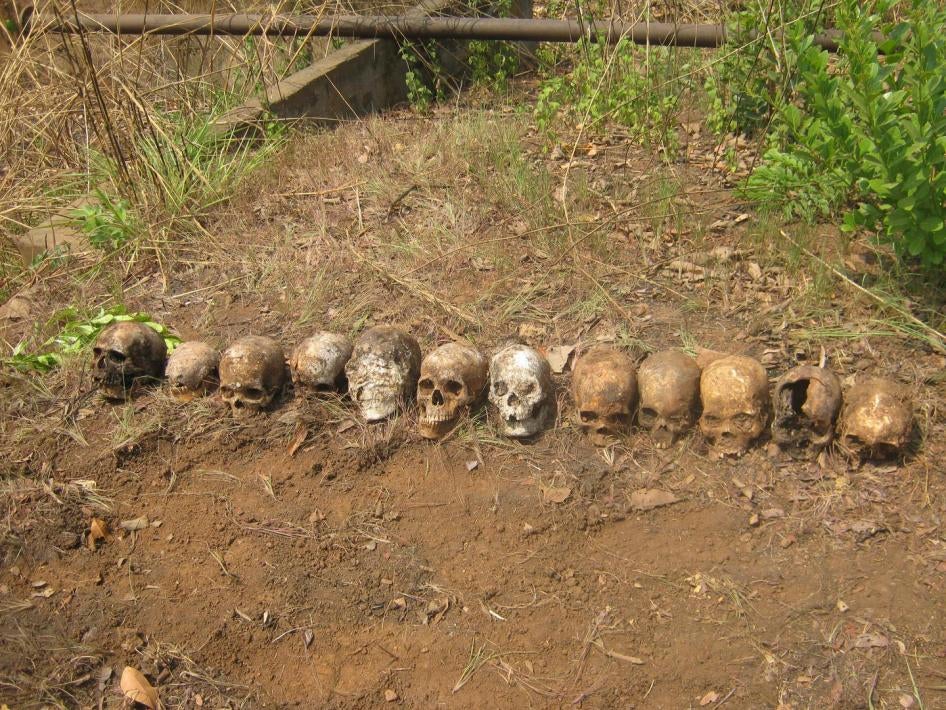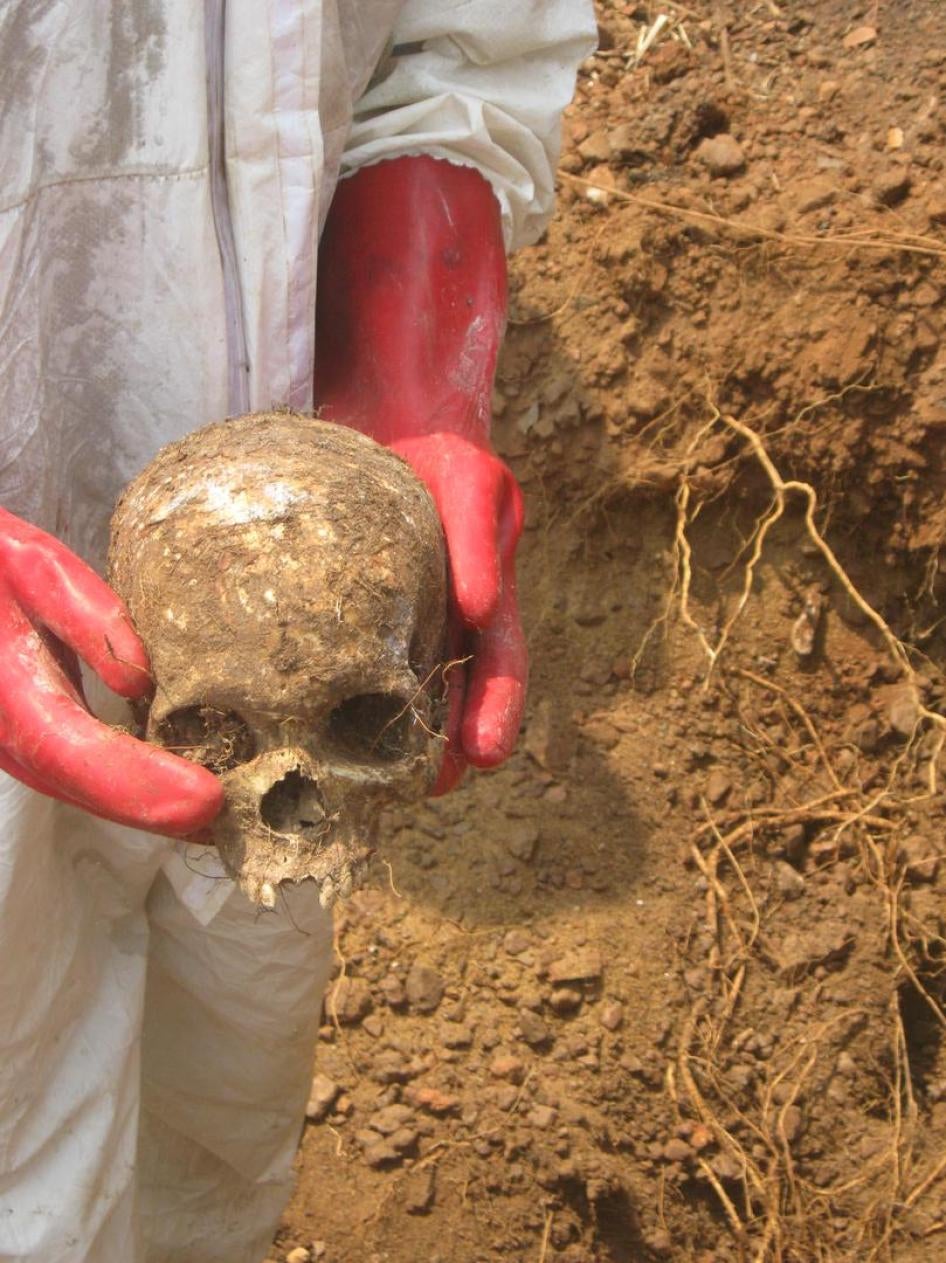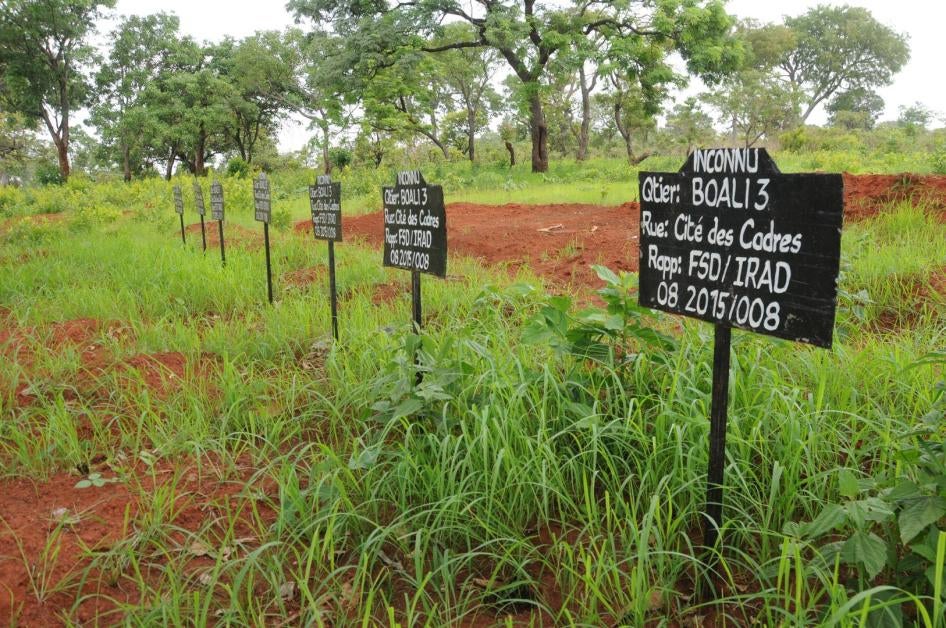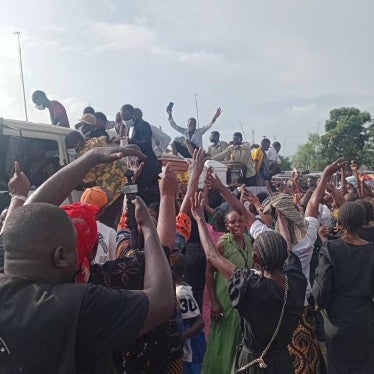(Nairobi) – Soldiers from the Republic of Congo killed at least 18 people, including women and children, between December 2013 and June 2015 while serving as peacekeepers in the Central African Republic. Two years after Human Rights Watch first reported on enforced disappearances by peacekeepers from the Republic of Congo, their government has taken no action toward credible investigations or justice for these crimes.
I argued with the MISCA and I said, “How can you tell me to go to my house?” But a friend said, “No, this seems serious, do not argue about this.” I saw a vehicle go down into the camp with people in it. I could not see who it was, but the people were civilians. They were not MISCA soldiers. We stayed inside for a few hours, then around 11 p.m. we heard many shots and screams coming from near the Captain’s villa. An hour later I heard another volley of shots. We heard the discussion between the volleys as to whether to kill the women and children.
Around 1 a.m. I saw their vehicles driving through the camp.
After the execution, the Congolese peacekeepers cleaned their truck with water from a pump near their villas, said witnesses Human Rights Watch interviewed in June 2015. “The next morning there was blood everywhere around the pump,” one witness said. Another witness said: “Even today there is still human hair near the pump.”
On June 3, 2014, after Human Rights Watch published its report on the disappearances, the AU issued a news release saying it had opened an investigation into the allegations and based on its findings would “take the required action in accordance with the rules governing the functioning of MISCA.” No information about this investigation has ever been made public. In March 2015, AU officials told Human Rights Watch that a report had been drafted, but they were not at liberty to disclose its contents or conclusions. When UN human rights investigators in March 2015 investigated the crimes committed by peacekeepers in Boali and in Bossangoa, they confirmed that MISCA’s Congolese contingent had committed enforced disappearance, torture and extrajudicial killings.
Discovery of the Grave
The local non-governmental organization exhumed the grave on February 16, 2016 in the exact location indicated by the accounts given to Human Rights Watch. Local residents informed the organization, whose responsibilities include removing corpses from wells and other water sources, about the mass grave, and the group received permission for the exhumation from local authorities. The exhumation took place in the presence of local authorities, including a representative of the national police, who described the exhumation in his police report as one of “anti-balaka [who] were kidnapped by MISCA, killed and buried here.” No forensic experts were present.
The exhumation revealed 12 skulls, clothes that matched the individuals who had been reported missing in 2014, and a number of anti-balaka amulets that had been worn by the general and his fighters. Those present at the exhumation said they did not believe the baby’s skull was found, although one of the skulls, significantly smaller than the rest, was thought to be that of a 10-year-old boy.
We have not forgotten what has happened. We want the MISCA soldiers to face justice. The people who are dead could have helped their families had they not been killed. We want a real investigation done, we are not satisfied with the investigation thus far. It is like the Central African Republic is nothing to the African Union. I sometimes think, “What if justice could be done? What would it look like if a real investigation was done?
Torture and Killings in Bossangoa by MISCA – 2013
On December 22, 2013, Congolese peacekeepers tortured to death two anti-balaka leaders in Bossangoa following the brutal lynching of a Congolese peacekeeper the same day. The incident, was first reported on by Human Rights Watch in June 2014, although it was witnessed by many local UN staff members and aid workers who were staying at the MISCA base at the time for their safety. Locked in a staff room during the incident, the UN staff and aid workers overheard the Congolese peacekeepers torturing the two men throughout the night. Their mutilated bodies were found the next day and seen by many witnesses who confirmed that the two men suffered extensive burns and saw evidence that burning melting plastic had been dripped on their bodies.
Executions in Mambéré by MISCA – 2014
On February 26, 2014, Congolese peacekeepers in Mambéré killed two anti-balaka fighters known as “Palasie” and “Court Pied,” at the town’s main crossroads in front of a large crowd of onlookers. Witnesses interviewed by Human Rights Watch April 2016 said that Congolese peacekeepers told them the two men had been captured the day before in the village of Bambio.
One witness who watched the executions said:
I saw two men with their hands tied behind their backs. There was a large group of people watching, maybe 200. All of the people were curious to see them. They forced the men to lay down on the ground. The MISCA commander took one of his soldier’s guns and he killed them…We were all shocked by what we saw. I had never seen someone killed like that.
Another witness said the peacekeepers encouraged people to watch the public execution yelling, “These are anti-balaka, we will kill them.” The witness said, that when a crowd had gathered, “the peacekeepers forced the two men out of their truck, made them lie down on the ground, and then shot them in the head and chest.” After the execution, the peacekeepers forced local residents to bury the bodies saying “If you do not bury these bodies right now we will kill three times as many people.” The residents buried the bodies in the cemetery behind the gendarmerie.
Excessive Use of Force and Killings in Mambéré by MINUSCA – 2015
On June 10, 2015, UN Congolese peacekeepers based in Mambéré detained and beat four men, two of whom later died from their injuries.
Based on Human Rights Watch research conducted in April 2016, peacekeepers detained the men because of a dispute about a woman between a peacekeeper and one of the victims. Human Rights Watch found no information to corroborate that the men had been involved in criminal activities, as MINUSCA alleged in a news release on June 10.
Three of the men – Alban Nambokinena, Kouvo Befio, and Douala Bakiko were neighbors. Witnesses said they were taken from their homes in the early hours of June 10 and severely beaten as they were arrested. Nambokinena said:
I heard a knock on my door around 4 a.m. and I opened it. There were the MINUSCA in military uniforms with their blue helmets.
At first I thought that maybe this was for some work so I went outside, but the MINUSCA grabbed me and started to beat me there in front of my house. At the same time, they pulled my neighbor Kouvo out of his house and started beating him too. They were kicking and beating us with their rifles. I knew that I had not done anything so I was yelling, “What did I do?” They were just beating me and speaking to each other in their own language.
Another witness, a friend of the arrested men, said: “When I saw the men put into the truck I tried to follow, but the MINUSCA pointed their guns at me and said, ‘If you follow us we will kill you.’ I just went into my house and cried.”
Together with a fourth person, Bernard Lamaye, the men were taken to the Congolese MINUSCA base at an area called “scierie” – a timber processing center – where the beatings continued for hours.
Nambokinena said:
When we arrived at the scierie, they really started to beat us seriously there out in the open. They did something they called “operation helicopter.” It was like this: four men would each grab a hand or leg. Then they threw us up as high as they could. We came down and landed on planks, they would kick us as we fell.
They were trying to break our bodies. I did not really hear what they were saying because the Congolese were speaking between themselves. They weren’t asking questions. They did not interrogate us or tell us to admit to something, they just beat us. They gave me the “operation helicopter” four times. I can’t tell you how it hurt my neck, back, and head. After some time I did not feel any pain though. I thought my back was going to break in two, I really thought that was happening.
Finally, when I could not feel anything, the commander said, “Ok, that is enough put them in the container.” This was maybe around 6 a.m. because the sun was coming up.
The men were locked in an old shipping container. Within hours one of the men, Douala, died from his injuries. Another, Befio, fell into a comma. Nambokinena said:
We started to cry. We called for the MINUSCA. A guard yelled, “Stop it! Don’t cry!” We said, “No, one of ours is dead!” The guard said, “If we open the door and we see someone is not dead, you will suffer.” But they opened the door and a MINUSCA soldier came in. He saw that Douala was dead. He saw straight away.
On learning about the death, the peacekeepers took the remaining three men to the hospital in Berberati, 125 kilometers from Mambéré. Witnesses said they saw the men being carried to the MINUSCA truck. One witness said, “It was clear they could not walk.”
The peacekeepers told hospital staff the men were thieves. Hospital staff and local officials said they recognized the men, knew them to be from Mambéré and did not believe they were criminals. Medical staff members said that Befio was in a coma when he arrived at the hospital. He died on June 14, 2015.
The day after Befio’s death, MINUSCA flew the two survivors to Bangui, the capital and took them by MINUSCA ambulance to a local hospital. Local authorities gave each one 50,000 francs (approximately US$85).
Under normal procedures, suspected criminals are transferred to Bangui by MINUSCA’s police force, UNPOL, at the request of national or local prosecutors and handed over to national authorities. In this case, the national prosecutor told Human Rights Watch he was not aware of any request from his office to transport the two survivors to Bangui.
Once they recuperated, the men left the hospital. They were not charged or given any other assistance. “We were quickly forgotten,” one said. After a month in Bangui, the men ran out of funds and hitchhiked back to Mambéré.
Nambokinena said:
If I am accused of a crime let them come arrest me. It is the MINUSCA who committed a crime. I have not recovered from this. I have pain in my neck, back, and hips. I have tried to work, but it has been difficult because my job is to move heavy wood onto trucks. I now need to ask someone to take my place because my job was so physical and you need to be strong. I don’t have the money to see a doctor. When I make a little money I get a doctor to give me medicine which will give me the strength to move around. It is difficult to move around too much and I now get bad headaches.
I think about what happened to me a lot. I am traumatized. When I see the Congolese in town I remember what happened. The population is still scared of the Congolese because of this.
I have two children and my life has changed for the worse. I can’t feed my kids like before. I don’t have the strength to work as I did. I now make less than half of what I used to make because my health has been affected. For all my troubles I was only given that 50,000 francs and I used it all in Bangui on medicine.
Twenty Congolese peacekeepers from the unit in Mambéré were repatriated after these killings. Human Rights Watch is not aware that any soldier has been held to account for the killings and serious beatings.
MINUSCA investigated the incident in 2015 and sent the results to the government of the Republic of Congo via a diplomatic note. To the best of Human Rights Watch’s knowledge there has been no response.
In April 2016 MINUSCA opened an internal investigation, known as a Board of Inquiry, into the incident. The Board of Inquiry will report on the internal procedures of MINUSCA and how the mission reacted.












